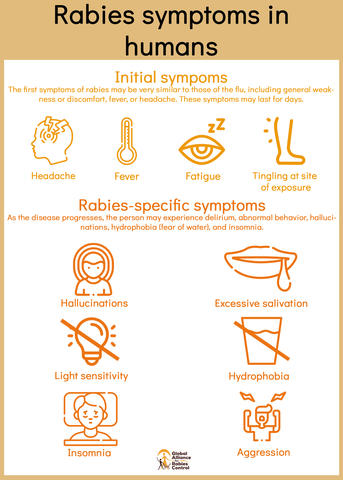Signs and symptoms of rabies
Rabies infection and prognosis
Following exposure to the virus, the onset of symptoms can take anywhere from a few days to over a year to occur, with the average time being 1 to 12 weeks in people. The time taken depends on how long it takes the virus to travel from the wound site to the brain, which is when symptoms begin. This is based on several factors, including where the infection occurred (distance from brain), how much of the virus entered the body, and the size of the infected individual (or animal). Therefore, if a large man was bitten on the foot, the time to onset of symptoms may be longer than if a small child was bitten on the face.
Rabies Symptoms
Rabies symptoms in people
The initial symptoms of rabies are similar to those of the flu - fever, headache, and generally feeling unwell. As the disease progresses, the person can experience delirium, abnormal behaviour, and hallucinations, as well as the infamous hydrophobia and foaming at the mouth (related to the paralysis of swallowing muscles). It is important to note however, that rabies symptoms can vary greatly, meaning that not every person will demonstrate all (or even many) of the typical symptoms.
Signs of rabies in animals
Rabies signs in animals are similar, with a change in behavior (either an aggressive or wild animal becoming tame and calm, or a calm animal becoming aggressive), paralysis or partial paralysis in many cases, abnormal vocalization (dogs barking strangely), animals attacking inanimate objects (like biting rocks or trees), hydrophobia and foaming at the mouth, among others. However, rabies in animals is even more difficult to diagnose without laboratory testing as the signs can vary so much in different cases. One thing is sure, is that all cases of rabies will eventually result in death once signs are present.
Why do we interchange the use of “symptoms” versus “signs”?
Symptoms refer to the disease in humans. People are able to more accurately describe their symptoms (how they feel, what the disease looks like, what is happening with the disease) to medical professionals, whereas veterinarians need to rely on the signs that are detectable in the animal, as the animal is not able to accurately describe how it feels and what may be occurring when the disease manifests.
